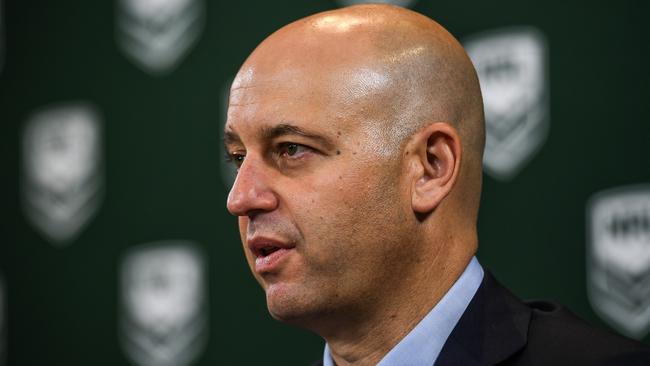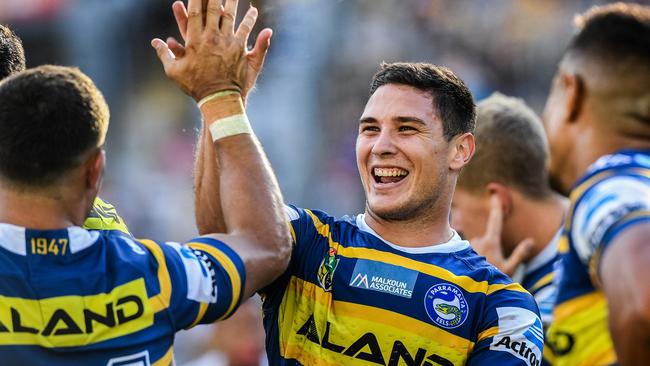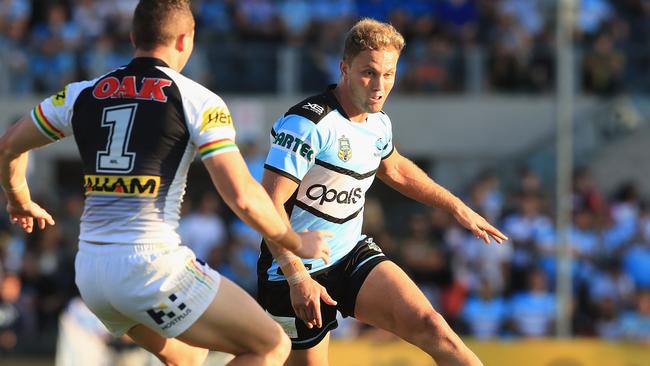Paul Kent: NRL’s #NRLtalkthegameup misses the mark on media coverage
TODD Greenberg and his little #NRLtalkthegameup campaign aimed at attacking the media have created a conundrum for this game. How do you talk up a game if the game doesn’t want to talk?
Opinion
Don't miss out on the headlines from Opinion. Followed categories will be added to My News.
TODD Greenberg and his little hashtag have created a conundrum for this game.
How do you talk up a game if the game doesn’t want to talk?
Greenberg began a social media campaign last week, #NRLtalkthegameup, and attacked criticism of the game from the media as coming from “crisis merchants”.
So now it is all out in the open.
STRIP CLUB: Six Sea Eagles fined $10k each
JACK BIRD: I’m better than this
HONOUR: Hunt and Cronk reflect on Anzac Day clash

Does the media ignore good stories to solely concentrate on the bad? Or is it possible there are times when with little co-operation they do the best job they can do?
Greenberg’s campaign has put a focus on the treatment and selection of media coverage and whether there was a better story to tell.
It works so long as the assumption exists that the players are doing their best to talk the game up but remain frustrated by an unwilling media.
That is not the case.
We will always be debating the performances of Clubs, players, administrators, referees, rules, etc but if you love Rugby League then talk it up & share your positivity. Ignore the crisis merchants & support your club & the game! #NRLtalkthegameup
— Todd Greenberg (@Todd_Greenberg) April 15, 2018
Agree @Todd_Greenberg. There will always be room for improvement, but rugby league is in its best position since I started playing...plenty to be positive about! If we are going to continue to grow as a game constructive feedback from everyone is important. #NRLTalkTheGameUp @NRL https://t.co/N1vWFheL8O
— Cameron Smith (@camsmith9) April 15, 2018
As one who had the honour of managing digital for @NRL in recent years, like @Todd_Greenberg I witnessed the relentless negativity of many within the game.
— Dave Ray (@daveray99) April 19, 2018
We always achieved more when we worked through issues together so we could #NRLtalkthegameup. I love #NRL and always will.
Parramatta finally cracked it for a win after seven rounds on Sunday.
After weeks of rumblings that halves Mitch Moses and Corey Norman were struggling to gel the two turned it on and ran one and two in the quinella for best on ground.
They were the natural story.
#NRLtalkthegameup.
Everybody was told to wait outside a changeroom door for Norman and Moses to come out.
Only they didn’t.
They escaped through a side door.

Aware they broke the rules, the NRL sent them back so they could tell the media they were not talking.
So the good news story died a little.
With no quotes, no insight and no first-hand experience it was no longer as good as it could have been.
Across town Matt Moylan led an understrength Cronulla to victory against his old team, Penrith, in his best performance for his new club.
Again, Moylan was the story. Again, he wasn’t talking. Didn’t feel like it.
#NRLtalkthegameup.

After Sunday’s win Jarryd Hayne, the injured Parramatta star who walked back onto the field to share a prayer with teammates, had no doubt what turned the Eels around.
“The emotion we’ve had to put up with and all the articles and that sort of stuff during the week ... what really set everyone off was the way they spoke about Brad saying he lost the changeroom,” Hayne told Fox League on Sunday.
“That was something that really stung all of us.”
After six weeks of poor effort it seems it took media criticism for the Eels to muscle up, sparked with a physical training session where blood got spilt.

Given that was their motivation you might think Norman and Moses might have hung around to thank the media rather than trying to backdoor them.
These small grievances happen every week and have been happening for years. And players have been allowed to do for years what Norman and Moses and Moylan did.
They are newsworthy now only because of Greenberg’s campaign.
#NRLtalkthegameup has created a focus on the media’s role but the players and the NRL cannot escape it.
They have it backward.
My job is not to talk up the game. My job is to sell newspapers. It is the NRL’s job to sell the game.
But in the confusion of roles the media has muddied the water by contracting players to their organisations for exclusive content.
I still receive messages like this from sharing my story for the State of Mind campaign. The positive impact we have in the community is so powerful #NRLtalkthegameup pic.twitter.com/fLtSpTRbOQ
— Joel Thompson (@joel_thompson12) April 18, 2018
The NRL added another layer to the problem with its new strategy to pay marquee players for marketing. There are 28 current and six former players contracted.
Under the new scheme, players earn points for doing extra work and the points, like flybuys, turn into cash.
The rationale seems sound but is deeply flawed. The thinking goes that players will see the extra money the big names are earning and will work hard to raise their own profile.
When the tide goes up, all the boats rise, goes the thinking.
But the players, with a trained eye, have realised the flaw in the system. If they resist doing any promotion the NRL will eventually step in with an incentive payment. To pay them on top of what many believe should already be their job, which is promoting the game that already pays them.
When the Rugby League Players Association was negotiating a 29 per cent share in the game’s total revenue as part of last year’s Collective Bargaining Agreement negotiations, which they eventually got and made them genuine partners in the game, the top-up payments were flagged as redundant.
But the NRL bowed.
Darrell Eastlake was a sports broadcasting giant not only of height but also of voice. This @BuzzRothfield piece on his time spent with Darrell as he lived with dementia is as good as anything you'll read #DarrellEastlake https://t.co/PiXjxVTuOh pic.twitter.com/OHxNYjQTER
— Michael Miller (@mm_newscorpaus) April 19, 2018
What happens when Origin comes around? No more interviews without an advance?
This, for a game where they are already being paid an extra $30,000 on top of hefty club salaries. And where they are already among the best paid at their club.
Enough is never enough, it seems.
One player earning big dollars this season was paid extra under the NRL’s bonus points system to promote Wednesday’s Anzac Day game.
To promote a game commemorating the Anzac Spirit.
Lest we forget.



